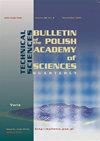低成本玻璃纤维聚合物在非延性桥墩抗震加固中的应用
IF 1.1
4区 工程技术
Q3 ENGINEERING, MULTIDISCIPLINARY
Bulletin of the Polish Academy of Sciences-Technical Sciences
Pub Date : 2023-11-06
DOI:10.24425/bpasts.2020.135383
引用次数: 4
摘要
本文章由计算机程序翻译,如有差异,请以英文原文为准。
Seismic strengthening of nonductile bridge piers using low-cost glass fiber polymers
. Several recent earthquakes have indicated that the design and construction of bridges based on former seismic design provisions are susceptible to fatal collapse triggered by the failure of reinforced concrete columns. This paper incorporates an experimental investigation into the seismic response of nonductile bridge piers strengthened with low-cost glass fiber reinforced polymers (LC-GFRP). Three full-scale bridge piers were tested under lateral cyclic loading. A control bridge pier was tested in the as-built condition and the other two bridge piers were experimentally tested after strengthening them with LC-GFRP jacketing. The LC-GFRP strengthening was performed using two different configurations. The control bridge pier showed poor seismic response with the progress of significant cracks at very low drift levels. Test results indicated the efficiency of the tested strengthening configurations to improve the performance of the strengthened bridge piers including crack pattern, yield, and ultimate cyclic load capacities, ductility ratio, dissipated energy capacity, initial stiffness degradation, and fracture mode.
求助全文
通过发布文献求助,成功后即可免费获取论文全文。
去求助
来源期刊
CiteScore
2.80
自引率
16.70%
发文量
0
审稿时长
6-12 weeks
期刊介绍:
The Bulletin of the Polish Academy of Sciences: Technical Sciences is published bimonthly by the Division IV Engineering Sciences of the Polish Academy of Sciences, since the beginning of the existence of the PAS in 1952. The journal is peer‐reviewed and is published both in printed and electronic form. It is established for the publication of original high quality papers from multidisciplinary Engineering sciences with the following topics preferred:
Artificial and Computational Intelligence,
Biomedical Engineering and Biotechnology,
Civil Engineering,
Control, Informatics and Robotics,
Electronics, Telecommunication and Optoelectronics,
Mechanical and Aeronautical Engineering, Thermodynamics,
Material Science and Nanotechnology,
Power Systems and Power Electronics.

 求助内容:
求助内容: 应助结果提醒方式:
应助结果提醒方式:


